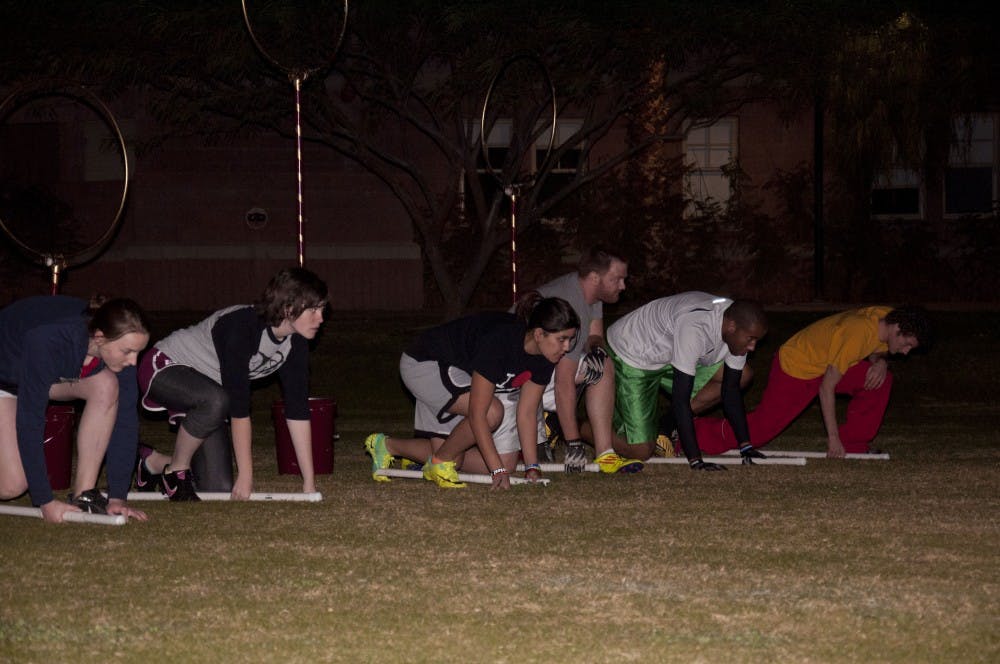As a kid, I always wanted to be a space cowboy. I’m sure you’ve dreamed of some crazy, unrealistic profession or activity too. But for now, I’m sitting in this concrete chair with no cushion, still dreaming of something that could’ve been.
Mind you, this is while other Arizona State University students are fulfilling their fantasies. You thought it could only be done in the movies, right? To my surprise, Harry Potter is totally real. Well, the game of Quidditch is.
In 2009, outside of Palo Verde residential hall, junior Alexis Bristor dragged chairs out from her dorm room and attached a hula-hoop to the top of each. She had taken responsibility in making the club “magical.”
“We know it’s ridiculous but that’s the point,” says Bristor, who is studying film and media production. “Freshman year you always go to orientation and hear ‘get involved!’.”
So Bristor did. With taking on the responsibility of coordinating the team, though, she also took on the ridicule from her peers. She shrugged it off. According to Bristor, a lot of them would eventually become fans of the sport. Even to her confusion, some would taunt them by using their own Harry Potter knowledge.
“They’d say things like ‘come on Harry, catch the snitch!’” Bristor says. Again though, she can’t help but to laugh because the past three years have been that magical.
If second place in the world up until this season isn’t magical enough, then consider my own dreams primitive. Up until this year they were unblemished. Through Bristor’s leadership, the team is currently 14th out of 103 in the International Quidditch rankings. They look to defend their World Cup title for the third consecutive year.
This is a hard task to accomplish despite their luck in the past. There are many facets to this game: dodge ball, football, volleyball… the list goes on.
There are no boundaries to the playing field but within this field—about the length of two basketball courts—there is the starting area. Within this area, there are six hoops, three on opposite sides.
The object is to score points by throwing the quaffle (a volleyball) through the hoops. This is where your three chasers come in; they are the team’s offensive power. With offense there is expected to be defense too. The keeper is like the goalie and the two beaters on the field can use bludgers (dodge balls) to disrupt the scoring process. Hit by one of these and you are temporarily removed from play until you touch your side’s goal hoops.
So where’s the little golden snitch come into play? The snitch in this case is “a little” bigger: it’s a person. A neutral representative dresses up in gold for the game with a flag attached to them. They have the privilege to hide, tackle and essentially do anything to not get caught. Each seeker on opposing sides wants to end the game by obtaining the flag.
The snitch is not the only person that can tackle. While every player has to have a broom stick in between their legs regardless, every player is also allowed to tackle. Quidditch is a full-contact sport.
This sport requires intensity, something junior Ben Little thought he didn’t have. During his freshman year in high school, Little played football only to realize that he lacked intensity.
Now, through the Quidditch transformation, he just can’t put a finger on his new-found intensity.
“I don’t know what happened!” Little says. “Maybe it was puberty, having a broom in between my legs,” he jokes.
Maybe it was how fast this sport had hit him. Not three days into his introduction to the sport he was playing in a tournament in Los Angeles. He was in the rotation; he was productive. Little, a management major, ended up scoring his first goal at the tournament and says he remembers just “screaming and running down the field.”
And even outside of Quidditch, when he plays other sports the game follows him. According to Little, when playing a game of pick-up softball, he had trouble running the bases because he did not have the broom stick in his hand.
“That’s when I found out Quidditch is a part of my life,” Little says.
So as I double over and try to daydream in this concrete slab they call a chair, these students at ASU are living a fantasy.
They have a top-tier, world-ranked team and they have seen exponential growth in participation. Bristor had only seen “three or four” willing participants to start her freshman year but now the team has reached a peak of 35 total players.
Though they have run into more adversity this year than what they ever have, adversity might help them re-climb the ranks.
Only time will tell, but what is certain is that they are coveting the golden years, taking advantage of the championships, camaraderie and the thunderbolt obsession.
Tell me more about what’s happening with the ol’ maroon and gold (No, not Gryffindor). My e-mail is bcapria@asu.edu.






